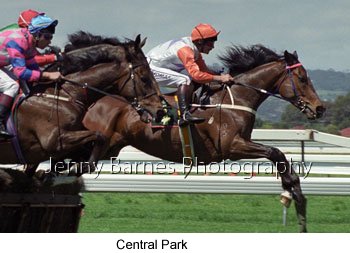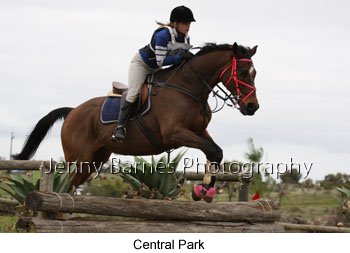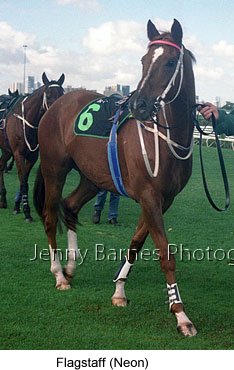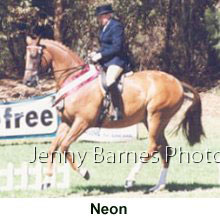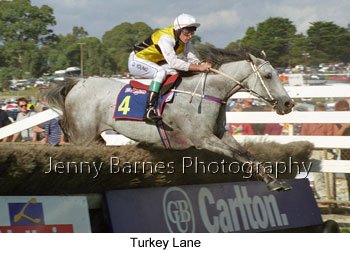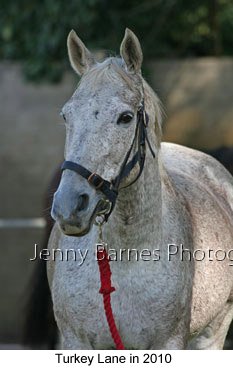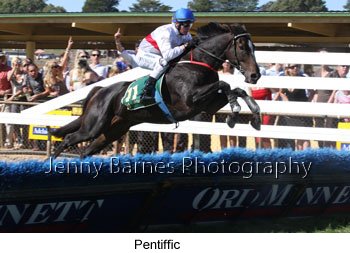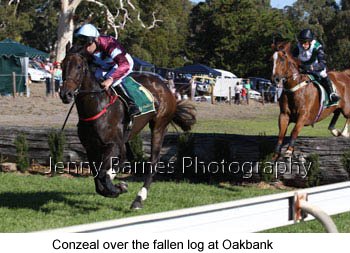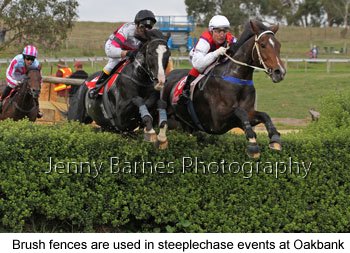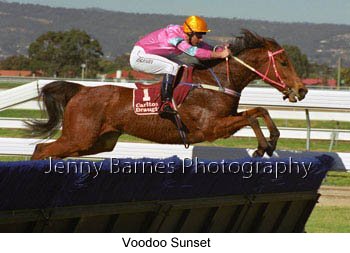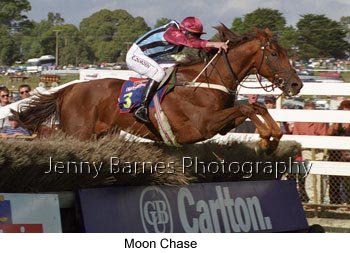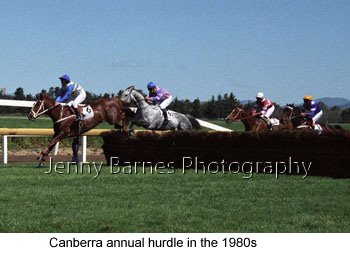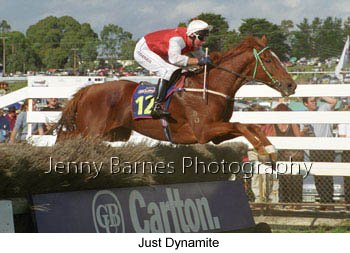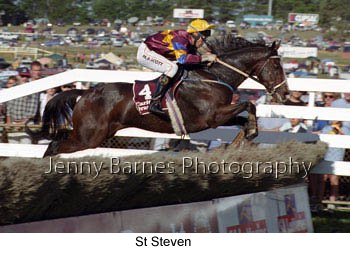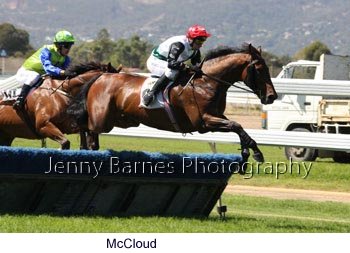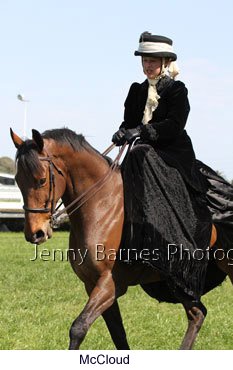|
Post Office Box 67 Fulham Gardens SA
Phone: 0412 208 011 |
||||||||||||||||||
Brief history of Jumps Racing in Australia |
|||||||||||||||||||
|
Jumps racing was introduced in the schedules of races run by Hunt Clubs in the early 1830s and was soon adopted by the various city race clubs. The early steeplechase courses featured post and rail and log fences, stone walls were common as were water filled ditches and steeplechase courses were added in and around the main racetracks. Nearly every racetrack had a dedicated jumps course where permanent obstacles remained - it was only in more modern times where jumps could be placed and removed between races that many of the inner jumps courses were removed. At the metropolitan racetracks the only recently remaining 'jumping lanes' were at Flemington, Moonee Valley and Oakbank (SA) but with the changes announced in Victoria the result was Sandown only having a specialist jumping circuit. Several Victorian country tracks such as Warrnambool, Casterton, etc also have jumping courses while the Melbourne metropolitan jumping was rescheduled to be concentrated at Sandown after the review in late 2008. Australia has had many champion jumps horses over the years with horses like Redleap, Redditch, Doiran, Fulham, The Feline, Mosstrooper, Winterset right up to Crisp being legends that are still discussed with some having a race in their name still run. Mordern day champs such as Sharp As, River Amos, St Steven and Karasi also made their name due to their feats over the jumps. Karasi was often behind the placegetters in the big Cup races but became a household name by winning the Grand Jump in Japan three years in a row and nearly attempted a fourth but a tendon injury in trackwork led to retirement. He along with St Steven have made numerous 'guest' appearances on racetracks in the last few years. The first of the four jumping states to cease racing over the obstacles was Queensland. In the 1890s the economic downturn & effects of the city flood disaster hit racing hard and while its carnival races had their prizemoney slashed the jumps racing disappeared from the calendar. Racecourses such as Bundamba (Ipswich) and a second course were not used for several years with one raceclub stopping meetings completely for nearly two years. The state racing industry only survived through the programming of small race meetings. The industry picked up again by 1899 but the jumps racing did not and by August 1904 hurdles were being run at Toowoomba but there was little interest. The sport did return briefly in the mid 1980s to early 1990s when a once a year exhibition hurdle was held following in the footsteps of Sydney and Canberra. These did not last long due to equipment, horses and jockeys all having to travel from Victoria resulting in small fields with the favourites usually winning by big margins however there were no notable incidents or injuries. Interest soon waned and jumps never returned to Queensland again as although never banned there wasn't the support for the costly exercise. Western Australia did experiment with a 'Perth Steeplechase' but it was only tried once in 1877 and never again while a hurdle racing did appear on a regular basis in the 1890s it was generally considered that with low prizemoney and small fields it would not be sustainable long term. While it survived early predictions once the depression occurred in the early 1930s the sport slowly declined in stakes and significance and eventually disappeared. Like Queensland it was economics not a ban that ended the sport in that state with the clubs having problems attracting entries for what was to be the opening race of the 1941 season on July 5th but it was deleted after not enough entries were received to make the race viable. Even if their had been enough horses there was also the issue of enough jockeys with the best already well established in Victoria for the longer and more lucrative season or many others signed up to fight in World War II. New South Wales tried to keep the jumps races going but as few of the country tracks (aside from courses in the Riverina which were accessible by Victorian trainers) the interest and pool of jumping horses was quite low by the 1920s. And by 1931 the rules allowed a horse that had lost its jockey to be remounted and ridden to the finish by racegoers if it was still possible to claim a placing. There were also allegations of corruption within the jockey ranks and this didn't help the image of jumps racing with the racing public. Various incidents, small fields and the overall poor quality of jumpers in NSW (for the big races the superior Victorian jumpers often came and took the prize from the locals) brought about the end of Steeplechase races in 1931. Hurdle racing continued on until 1941, despite the small fields, when it and midweek racing were suspended due to World War 2. Despite assurances it would return after the war it was never revived. In November 1985 there was an annual exhibition hurdle race at Rosehill and while it race itself was a success with no incidents and went on to continue for a number of years like Queensland the interest didn't justify the cost of importing the equipment, horses and jockeys from Victoria and it was consigned to history in the early 90s. For unknown reasons at the time in 1997 the Greens introduced a bill in regard to making it unlawful to run a steeplechase or hurdle in NSW (click here for link - please note you have to go about halfway down the page it was put through with making it an offence to confine birds by a leg ring and chain on the same bill). Linking it with confining birds via a leg chain may have swayed some votes from members who believed it was a dead sport at that time so didn't matter (it was 19 v 17 votes) and strangely the following bill to outlaw steel jaw traps in NSW was not passed. Canberra briefly introduced a once a year hurdle race at its Canberra Cup meeting in the 1980s with the final version won by Cobbler Boy in 1988 (photo of this race is below). The races themselves were incident free but after an after race scandal over the event one year the interest waned and the club went to an all flat race program in 1989. Finally Tasmania's racing industry started to struggle in the years leading up to jumps racing ceasing in 2007. Track and race club rationalisation was put into place and as jumps racing the previous year consisted of only 19 horses (only 7 were from local stables the rest from Victoria) competing in 6 races. Even the jumps had been imported from Victoria. Again an economic decision - the sport itself was not banned. The final two remaining states that still at this stage have jumps races are Victoria and South Australia. In Victoria several years ago small yellow jumps were introduced to placate the various protest groups who were extremely vocal in regard to falls at the metropolitan jumps race meetings. While the first season or so the new jumps did show promise and improved the falls statistics unfortunately as many predicted the horses soon learnt they could just gallop over the obstacles at a greater speed by skimming through the forgiving brush. This led to mistakes and ultimately greater chances of race falls and injury. After a review in 2008 many improvements such as raising the angle of the obstacles and ensuring white sighter lines on the takeoff side plus many other recommendations and in 2010 new fences from France were introduced and were well received. In South Australia the same type of blue brush hurdles have been used since 2000 and jumps racing itself had no fatalities from the end of April 2003 to May 2008 - a five year stretch that many condemning the sport are either unaware of or not prepared to acknowledge. In the second half of the season the Victoria yellow modular jumps were introduced and while there were no issued the blue hurdles were back in 2009 with extra padding on the takeoff side and white 'sighter' lines both to increase the safety. Due to the low number of steeplechases outside Oakbank a number of different fences have been tried with 2011 seeing the introduction of new blue steeplechase fences while Oakbank has replaced the jumps seen below in the photos of Moon Chase, St Steven etc with live hedges as jumps which encourage the horses to respect the obstacle while being forgiving if they make a mistake.
Misconceptions of jumps racing 'It
makes no difference to the horses future after racing' 'They
only have short careers anyway spanning only a year or so and a handful of
starts for most' South
Australia has had many old campaigners who returned year after year before
heading for retirement Ryazan had 45 starts over the jumps
over 7 seasons and was a showjumper well into his older years while Voodoo Sunset after
a long career on the flat then had 16 starts over jumps for 6 wins and is
still active now as one of the Tafe SA horses. Turkey Lane who won the
Great Eastern Steeplechase at Oakbank had 47 starts over jumps over 6
seasons and as can be seen below returned to make a guest appearance & lead
the field out in 2010 at Oakbank while Just Dynamite, another Oakbank
regular, had 59 jumps starts over 6 seasons. Yet another SA horse was
Noah Yarn who raced over jumps for 7 seasons recording 54 starts for 5 wins
and 12 placings while another horse Cash On was on the scene a little
earlier than most mentioned here but he had 64 starts over jumps for 8 wins
and 18 placings before being retired in 1997. These are just a few
examples that I could think of from a small group of regular competitors in
South Australia there would be plenty more that have remained in Victoria.
'The jumps are flimsy and
nothing like the ones overseas' In South Australia the
obstacles were changed in 2000 to a newer hurdle topped with blue brush.
This type of jump proved an obstacle that horses respected while it would
give and even fall flat if hit hard enough - the fact that Adelaide went
without a serious injury using these jumps for 5 years from 2003 to April
2008 proved it was the right decision staying with its own jumps and not
following Victoria. The same jump was used up until May 2008 when
under pressure from Victoria to entice Victorian horses across the border SA
switched to the yellow modular jumps. These were only used until the
end of the 2008 season and didn't not cause any problems as the local horses
didn't have time to learn not to respect the new jumps. From the start
of the 2009 season the blue brush topped jumps were back but had padding
added to the takeoff side plus white sighter lines to improve safety.
The steeplechase fences have changed over the years with the fences seen
below at Oakbank being replaced with the yellow ones from Victoria while the
club was growing the hedges at each jump. With no issues since 2003
over the steeplechase fences whether they were the older style seen below or
the yellow topped modular ones that were used in the interim the club has
made the changeover to all jumps being live hedges. Hedges are
thought to garner respect from horses as obstacles as well as offer plenty
of give if a mistake is made giving the horse a chance to recover its
footing. At other courses 2011 saw the introduction of new blue
topped steeplechase fences whish have plenty of padding & sighter lines on
the takeoff side and look solid to horses so they jump rather than trying to
brush through. The jumps now being used don't look all that much
different to the ones used at various New Zealand courses (I saw one course
that had green brush topped jumps that had a base that looked only a little
more solid than the SA blue ones) excluding Ellerslie and its impressive
huge brush course. No - in fact compared to all
horse sports the numbers are comparable often lower. All equestrian
sports carry risk to participants and every incident leads to a full
investigation into exactly what happened and how to make the sport safer.
In South Australia in 2013 and 2014 there were no deaths in jumps races and
in fact in 2013 there were no falls just one horse that dislodged a rider in
the final race of the season. In 2012 in South Australia there were no
deaths in hurdle races either. The risk is always there and no horse
sport can guarantee there will no incidents but safety improvements pushed
from within the racing industry has made the sport safer over recent years.
|
|||||||||||||||||||
|
|||||||||||||||||||
Barnes Photography Home Page
| About Jenny
Barnes |
|||||||||||||||||||
